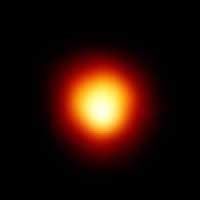Colours of the stars

The stars are points of light in the darkness of space. Many times, looking at the naked eye, most stars look white. They are coloured. Some red, others blue and others yellow. Betelgeuse, the well-known star of the constellation of Orion, is red. Vega, light blue or whitish. Arturo, an orange giant. Our Sun, as we all know, is yellow, etc.
Importance of color

Also, if you want to know something about a star, the first feature to analyze is color, since it informs us of the star temperature. Thus, knowing the temperature, you can know what is happening inside the star, whether it is young or old and many more things.
The hottest stars are blue and the coldest are red. Among them is a full scale of colors: blue to white, white to yellow, yellow to orange and orange to red. This color scale is accompanied by a classification by letters. In fact, astronomers decided to express each type of star with a letter, and invented a curious phrase to remember them: Oh, be a fine girl, kiss me. Behind these classifications and letters are hidden the colors of the stars. In this sense, the stars O and B are blue and the red K and M. Among others.

Image of the star Betelgeuse, raised by the Hubble telescope. (ANDÉN/ESA).
Probably, on a day-to-day basis, we would relate the red color to fire and heat, and the blue with the coldest, like ice. Well, we are very far from reality. Yes, at least, when talking about the stars and their temperature. In this case, the red color is warm and the blue is very hot. As mentioned above, these colors indicate the surface temperature of the stars: the red stars are the lowest temperature, approximately 3,500 degrees Celsius, while the blue ones have a temperature of about 30,000 degrees Celsius. The Sun is a yellow star with a surface temperature of about 6,000 degrees. Even if it seems surprising, our Sun is a rather cold star. However, the main reactions occur inside a star, which is always much hotter. The outer layer of stars, which usually have a very high interior temperature, is usually also hot, so they emit photons of great energy. The high energy photons are blue and the lowest energy photons are red.
In addition to blue, red, yellow… there are brown and black stars. The browns hardly have strength to create their own light and are neither stars nor planet. Blacks are hypothetical stars, they have never been detected, but in theory they exist.
The light emitted by a star, therefore, depends on the surface temperature of the star. That is, the temperature of the star marks the color of the star. On the contrary, looking at a star and seeing what its color is, we can deduce what its temperature is. The analysis of the light of the stars allows to deduce more than we think and is what astrophysicists do. Among other things, they provide information about the properties of celestial objects by analyzing the light they emit.
Published in 7k
Buletina
Bidali zure helbide elektronikoa eta jaso asteroko buletina zure sarrera-ontzian











